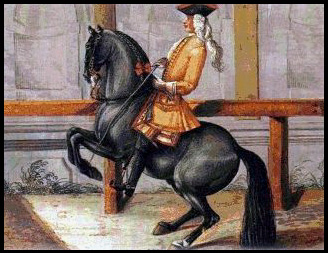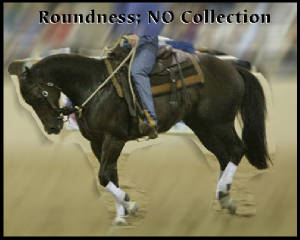|
Why Natural & Classical Horsemanship?

To me as a rider, trainer and teacher, Natural Horsemanship and Classical Horsemanship are the perfect combination. Developing
lightness, obedience and balance in a horse; while producing a caring, feeling and balanced rider as well. Both also encompass
using what comes natural to the horse and building from there.
Natural Horsemanship opened my mind to really learning about what makes a horse a horse. Seeing things from their perspective
and using the natural talents and abilities toward training goals. I learned that the physical part of things where much
easier than the mental and emotional side. Working for over 10 years with "problem" horses and starting young horses
under saddle has given me alot of knowledge to draw from......yet I was not completely satisfied.
The more I learned about the physical development in a horse, the more I saw how alot of excercises used in Natural Horsemanship
were counter-productive. While they may have gotten some points across to the horse on a psychological level, it was producing
some bad habits in both horse and rider physically.
Another thing I found lacking in the Natural world was correctness in performance movements, collection and even lead
changes. I got tired of over-flexing my horse to the point they were rubber-necked, and by the time I wanted more correctness,
I had nothing in the way of a horse moving forward to contact (as light as it may be). The flexing also taught them to give
the head, but did not give the jaw....something that is very neccessary. Many horses learned to "give" the head,
yet there was nothing relaxed and supple about it.
Recently, I hear alot of Natural Horsemen using many catch-phrases and talk of collection and flexion. Sadly, I have
yet to see one that has come even close to what the Classical Masters acheived. I still see alot of over-flexing of the head,
without changes from the hind or over the back. Notebly, I also have seen alot of pulling and kicking being done now toward
the goal of "collection".

Classical Horsemanship is an Art. While there is a systematical foundation and education, they are based on principles and
not specific formulas. It is as much of gaining knowledge, as applying it - which is the same in Natural Horsemanship as
well - at least how I see it.
The Masters worked dilegently at their Art, even when they went against all other tradition and belief. The goal was
to produce an agile, willing and obedient horse.
A horse can be conditioned to work off of any cue system you may dream up, but this does not mean it is by any means correct
or helpful to the horse in understanding your wishes or executing them successfully. An "aide" is only an aide
when is is timed and given in a way that helps the horse to naturally attain the movement or task; not hinder. This means
that we first must have a solid understanding of what is takes for the horse to not only perform, but continually develop
positive responses and physical balance.
This is where ground work (or working horses in hand) is so beneficial for all involved. First we must see with our own
eyes what it takes for the horse to not only prepare himself for each task, but to execute it in the best way possible. This
is also done without the burden of first a saddle and a rider. This allows the horse to freely develop himself and become
familiar with new lessons.
Change and adaptation must be a part of any training with a horse, though this is often an obstacle for the human. Constantly
working with the horse on their level at that moment, while leaving selfish expectations behind is yet another lesson we must
all learn.
Classical Horsemanship is not an end to a means, but rather a means to an end.
(more to come...)
|

